Speech Volatility and Market Pricing

Guy Debelle
[*]
Assistant Governor (Financial Markets)
Speech to Citi's 6th Annual Australian and New Zealand Investment Conference
Sydney –
- Audio 17.1MB
- Q&A Transcript
Today, I will talk about a few issues around pricing in financial markets and volatility, or more precisely, the lack of volatility.
Volatility
Financial markets have been quiet, maybe too quiet, for much of this year. Of course, in saying this it increases the likelihood of it ending sooner rather than later! Indeed, since drafting this speech, the VIX has risen to its highest level since February.
If I had told you that there were heightened tensions in the Middle East and Eastern Europe, uncertainty about the turning point in US monetary policy, a succession of strong US job numbers, uncertainty about the future direction of policy in Europe and Japan, as well as increased concern about the strength of the Chinese economy, you would not be expecting that to make for a benign time in financial markets. But that is what we have seen for much of this year. The graph shows measures of volatility in fixed income, equity and foreign exchange markets. At some point this year, all of these have fallen to historically low levels. There has been little reaction to any of the events I have described. To the extent there has been any, it has been very short-lived.
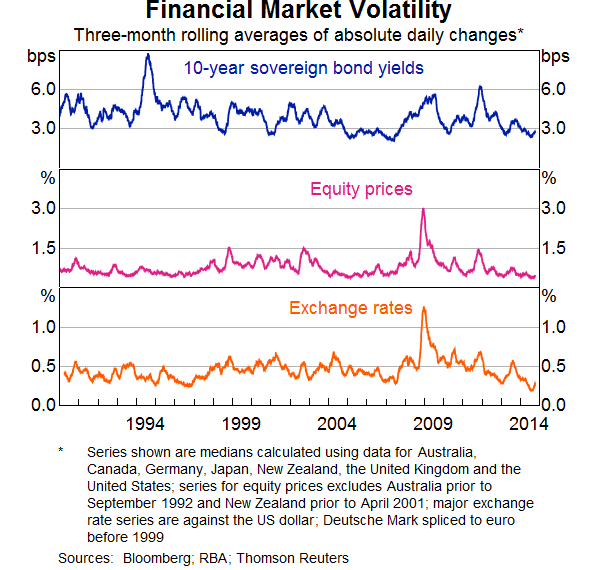
In the past few weeks, volatility has picked up, predominantly in foreign exchange markets, which I will come back to a bit later. But even so it has not yet returned to a ‘normal’ level of volatility.
So volatility has been low for a prolonged period of time in the face of a number of events which individually would normally be associated with high volatility, let alone all of them happening at the same time. Why is this happening? A number of explanations have been advanced, but I don't find any of them particularly compelling, mostly constituting, at best, only ex post rationalisations.
Macroeconomic outcomes for the world in aggregate have been relatively stable and that may be part of the story. World growth has been running at around 3½ per cent for the past couple of years and the latest forecasts have it continuing at that pace for the next year or so. But the relatively stable aggregate outcome masks quite a lot of variation across countries. A good example is the high volatility in growth in the first two quarters of this year in the US and Japan, the former resulting from weather, the latter from the consumption tax increase.
Nevertheless, the relative stability of macroeconomic outcomes might be delivering a little more stability in the numerator in investors' calculation of expected future returns. But it is not clear to me why there should be more stability in the denominator, the discount rate. If anything I would argue the converse, namely there is at least as much uncertainty about the future path of interest rates as in earlier periods.
One popular argument for stability is that the low volatility reflects the forward guidance of central banks. This has purportedly reduced uncertainty about the outlook for policy.
Two-way volatility in interest rates has naturally been restricted as rates have moved towards the zero lower bound, but much of this effect has been present for some years now. Moreover, with the zero bound being reached, policy uncertainty should translate to uncertainty about the use of other non-conventional tools to ease monetary policy. That is certainly true in Japan in recent years and more recently has been the case in Europe.
But more importantly in my view, while there is more forward guidance from central banks in place than in the past, investors don't have to believe it! Indeed, there are plenty of examples in history where that has been the case. I find it somewhat surprising that the market (in aggregate at least) is willing to accept the central banks at their word and not think so much for themselves.
Moreover, as has been articulated any number of times, the guidance is clearly data dependent. If the data moves unexpectedly, in all likelihood so will the central bank. Markets appear to be underestimating that possibility.
One thing which is certain is that the low volatility will not persist. What will cause it to end? I really don't know, as any of the events I mentioned earlier could have been a trigger for more volatility, but clearly they weren't.
One interesting market development is how cheaply volatility protection has been sold over recent months. There has been an increase in supply as more institutions who have not been traditional sellers of protection enter this market seeking returns as part of a search for yield. While that may have dampened volatility of late, it does mean that losses will be incurred if volatility rises before the insurance expires. These non-traditional players may pull back from the market in such circumstances, exacerbating any rise in volatility when it finally eventuates.
Market liquidity
One other factor which market participants are concerned about is the prospect that when a sell-off comes, the volatility and price movements will be exacerbated by the reduced capacity and inventory of market makers. That is, market liquidity is structurally lower now than it was in the past. The lower liquidity is not evident in a rising market when assets are being bought, but will quickly become apparent in a down market as investors try to exit their positions.
It is true that there is not as much market-making capacity as prior to the crisis. There are various metrics that demonstrate this and there have been some well-publicised exits by various institutions from different markets. Regulatory changes have, as intended, increased the cost of market-making, and hence shifted some liquidity risk to end investors. There have also been some strategic decisions taken by institutions and internal constraints have been imposed which have reduced capacity. The latter may have had at least as large an effect in reducing capacity as that of regulation.
But it should be noted that the pre-crisis level of market liquidity was one where there was over-capacity, and hence not the benchmark to be regained. The question today is whether there is too little capacity.
Unfortunately, we won't really ever know the answer to this question. When volatility returns, for a number of reasons, including those I have already mentioned, it may well rise quite rapidly. One thing I am sure of is that the spike in volatility will be blamed, rightly or wrongly, on regulation-induced reductions in market-making.
But if we look back at previous market sell-offs, when market-making capacity was larger, we see that they were often quite violent too. Market-makers can pull back in an environment of rapidly falling prices, either directly, or indirectly by significantly widening bid-offer spreads. Market makers generally have just as much reluctance to catch a falling knife as any other market participant. They are after all intermediators of risk, looking to lay it off quickly, rather than being a warehouser of risk.
The bond market sell-off in 1994 is a good example. (By the by, I recall '94 quite well. At the time, I was the teaching assistant for Stan Fischer in the graduate macro course at MIT. He and I might be revisiting those events again soon in somewhat different occupations to our more sedate academic lives then.)
There are a few other reasons to suspect that the sell-off, particularly in fixed income, could be relatively violent when it comes.
First, there are a number of investors buying assets on the presumption of a level of liquidity which is not there. As I said earlier, this is not evident when positions are being put on, but will become readily apparent when investors attempt to exit their positions. If you are a buy-and-hold investor focusing on the return on your investment, then secondary market liquidity is not really an issue (though it might affect your mark-to-market valuations on the way through).
But there are probably a sizeable number of investors who are presuming they can exit their positions ahead of any sell-off. History tells us that this is generally not a successful strategy. The exits tend to get jammed unexpectedly and rapidly.
On top of that, my time in financial markets has taught me that one should never under-estimate the role of mechanical rules or mandates in driving market behaviour more than rational pricing.
So there is a fair chance that volatility will feed on itself. One should always be careful of looking for too much rationality in trying to understand market dynamics. Given the lack of rational arguments for the current state of affairs, trying to rationally explain how it will unwind is also going to be difficult.
Another reason to suspect that the sell-off might be violent is the starting point, namely zero nominal interest rates. That is a point we haven't started from before (with the possible exception of Japan). There are undoubtedly positions out there which are dependent on (close to) zero funding costs. When funding costs are no longer zero, those positions will blow up. Where are they? How large are they? I don't really have a good answer to those questions. It appears more likely that they are held by real money investors than directly on the balance sheets of the core banking system, which is probably a good thing. But then if we think back to 2007, structured investment vehicles weren't directly on the balance sheet of the core banking system either.
Related to the issues above, looking at pricing in fixed income markets globally, and most easily in US Treasuries, there is little in the way of term premia (that is, return for holding duration). There also appears to be very little uncertainty priced in about the movement in short term interest rates. At the end of last year, the term premia had started to rise, separate from any increased uncertainty about short rates. This separation was a good thing. But those premia have now fallen right back. My concern is that both of these will rise in concert, exacerbating the disruptiveness of the sell-off.
In thinking about the magnitude and nature of any sell off, an important question to think about is who will take the other side of the trade? How far do prices need to go before someone is willing to take the position? Those questions are always relevant but the answers may be different this time around.
I will now turn to look at some pricing developments in the foreign exchange market where as I mentioned earlier, there has been some return to more normal levels of volatility in recent weeks.
FX
The main development in foreign exchange markets in recent months is that the US dollar has appreciated. This has been a long-awaited event by many market participants, including ourselves. A sizeable number of macro funds had lost a fair amount of money over the past year waiting for this event to happen.[1] Why the US dollar stayed at its low levels for as long as it did, and why it finally started to appreciate when it did, has baffled many in the market. As Keynes famously said, ‘the market can stay irrational longer than you can stay solvent’. A few well-known hedge funds came close to proving that proposition over the course of this year.
The appreciation of the US dollar was not associated with any noticeable change in interest rate expectations in the US, and, in the case of the AUD/USD exchange rate, there was no material change in Australian interest rate expectations either.
While the US dollar has appreciated, on a trade-weighted basis it is still not that far above its all-time lows reached in 2011. It has only appreciated by 4 per cent in the past few months, which is a small move in the history of swings in foreign exchange rates, where movements of up to 40 per cent have occurred. Similarly, while the euro has depreciated in recent months, on a trade-weighted basis the euro is not particularly low.
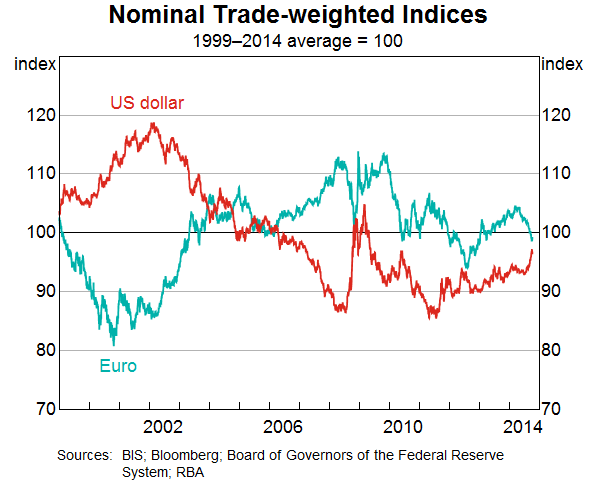
More generally, we are in an unusual environment where monetary policy settings in the four major economic regions – the US, China, Europe and Japan – are moving in divergent directions. It is an extreme environment that both markets and policymakers are operating in, where the balance sheets of major central banks are at an unprecedented size. It is challenging for foreign exchange markets and it creates a complicated environment for setting monetary policy in other parts of the world, including here in Australia.
The appreciation of the US dollar in recent months has received a fair amount of attention. What has attracted less attention is that over the same time, the renminbi (RMB) has moved in lock step with the US dollar, so that it too has undergone a sizeable appreciation. Over the past year, the RMB has appreciated by 5 per cent on a trade-weighted basis, while over the past 3 years it has appreciated by 13 per cent.
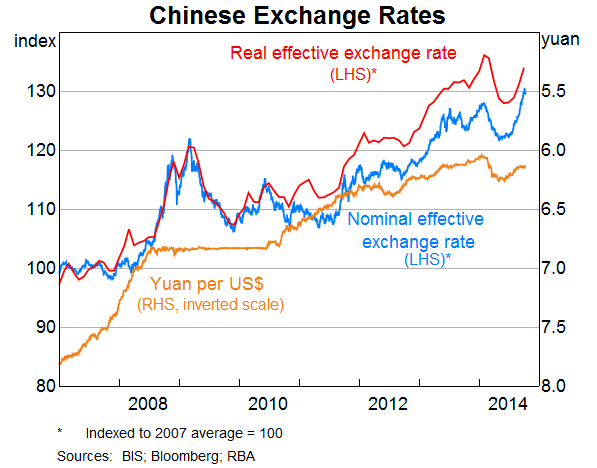
One noteworthy development over the past few months in foreign exchange markets is that volatility in emerging market currencies has generally been fairly contained while the US dollar has appreciated, certainly in comparison to the experience in the middle of 2013.
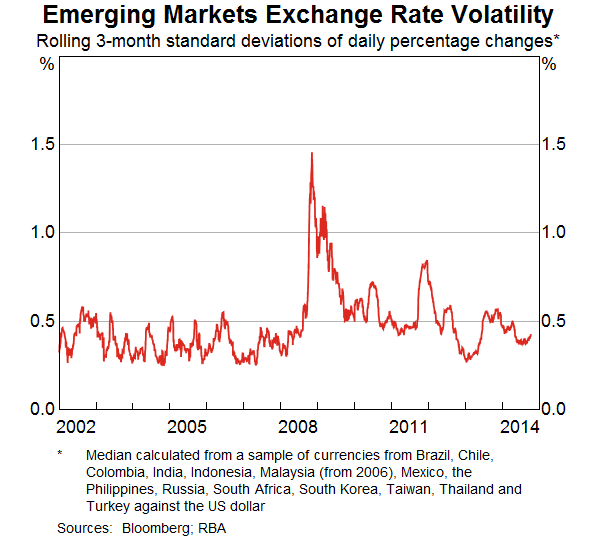
Turning to the Australian dollar, over the month of September the Australian dollar recorded one of the larger depreciations against the US dollar, at around 6 per cent. Given that, and the fact the RMB continued to move in line with the US dollar and has the largest weight in the Australian dollar trade-weighted index (25 per cent), that translated into a trade-weighted depreciation of the Australian dollar of 4 per cent over the month of September.
While that depreciation will do something to foster more balanced growth in the Australian economy, it has only served to take the trade-weighted index back to its levels of earlier in the year.
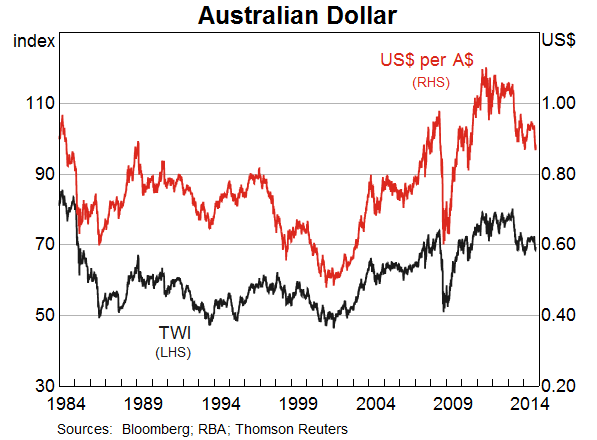
In part that is because the depreciation of the Australian dollar in September only saw it partly catch up to the depreciations which other currencies had experienced in previous months. So for instance, the Australian dollar is still 6 per cent higher against the euro since the beginning of the year. Why the Australian dollar held up for longer than other currencies prior to September is not clear.
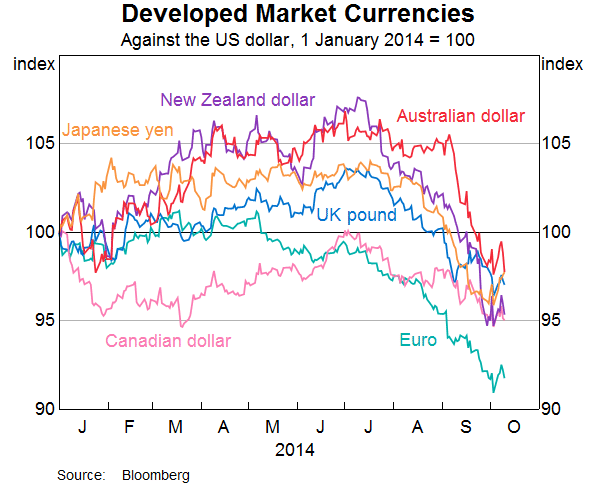
Again, the Australian dollar has depreciated in recent weeks, but on a trade-weighted basis is only back to levels of earlier in the year. Over that same period, Australia's terms of trade has continued to decline and some key commodity prices for Australia, most notably the iron ore price, have declined considerably. On that basis, the Australian dollar is still higher than most conventional estimates of fundamentals would indicate, notwithstanding its recent decline. The exchange rate is thus offering less assistance than would normally be expected in achieving balanced growth in the Australian economy. A lower exchange rate would be helpful in achieving that objective.
So in conclusion, there are a number of anomalies present in financial markets in terms of pricing and volatility. There are also some misplaced perceptions amongst market participants about the degree of liquidity present in some market segments. That strikes me as a dangerous combination and unlikely to be resolved smoothly.